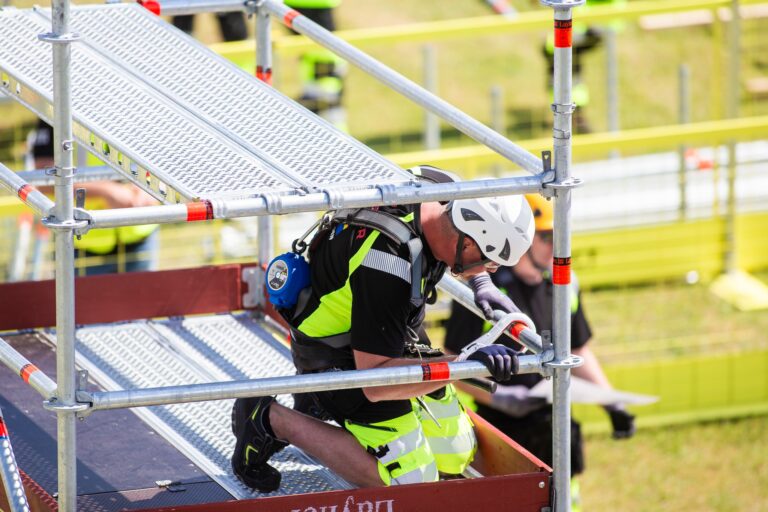- Los Angeles – 01:40
- New York – 04:40
- Dallas – 04:40
- Lima – 03:30
- Santiago – 04:40
- São Paulo – 05:40
- London / Dublin – 09:40
- Warsaw / Berlin / Paris / Madrid / Rome – 10:40
- Oslo / Stockholm / Copenhagen – 10:40
- Istanbul / Athens / Bucharest – 11:40
- Vilnius / Riga / Tallinn / Helsinki – 11:40
- Cape Town – 11:40
- Dubai – 12:40
- Ulaanbaatar – 16:40
- Tokyo – 17:40
- Sydney – 18:40
ScaffChamp Buildup: How to Watch the Action Live Around the World
CISRS Scaffolding Training Returns to Yorkshire with New Wakefield Centre
 Aecor’s team of instructors bring over 30 years of experience to their teaching. The courses not only cover the technical aspects of scaffolding but also focus on current health and safety regulations and compliance, aligning with the latest industry best practices.
Successful trainees will be eligible for the appropriate CISRS cards – essential for working on UK construction sites.
Aecor’s team of instructors bring over 30 years of experience to their teaching. The courses not only cover the technical aspects of scaffolding but also focus on current health and safety regulations and compliance, aligning with the latest industry best practices.
Successful trainees will be eligible for the appropriate CISRS cards – essential for working on UK construction sites.
 The Wakefield Centre now serves as a regional hub for scaffolders seeking certification without the need to travel further afield. The return of accredited CISRS courses to the area has been seen as a positive step forward in meeting industry demand and improving access to training.
Aecor International already operates training facilities in Nepal, the UAE, and Qatar. The move into the UK market, the company says, reflects its ongoing mission to support scaffolding excellence and raise standards globally.
More details and upcoming course dates can be found at: www.aecorintl.co.uk
The Wakefield Centre now serves as a regional hub for scaffolders seeking certification without the need to travel further afield. The return of accredited CISRS courses to the area has been seen as a positive step forward in meeting industry demand and improving access to training.
Aecor International already operates training facilities in Nepal, the UAE, and Qatar. The move into the UK market, the company says, reflects its ongoing mission to support scaffolding excellence and raise standards globally.
More details and upcoming course dates can be found at: www.aecorintl.co.uk Star-Studded Line-Up Announced for 2025 Scaffolding Excellence Awards
The NASC has announced that its prestigious Scaffolding Excellence Awards 2025 will be hosted by a trio of household names, Clare Balding, Alex Jones, and Leigh Francis at a glittering ceremony in Manchester this September.
Taking place during Scaffex25, the awards evening is widely regarded as the highlight of the scaffolding and access industry calendar, offering a rare moment to celebrate standout achievements, innovation, and excellence across the UK sector.
This year’s ceremony brings together a formidable hosting team:
-
Clare Balding – an award-winning broadcaster and author, renowned for her Olympic coverage, documentaries, and campaigning work. She was awarded a CBE in 2022 for services to sport and charity.
-
Alex Jones – one of the UK’s best-loved presenters, known as the face of BBC’s The One Show. She has fronted a wide range of factual and lifestyle programmes and is a passionate advocate for family, wellbeing and community causes.
-
Leigh Francis – comedian, actor and writer, best known for his character Keith Lemon. While Keith may be on “permanent holiday,” Francis is expected to bring plenty of humour and energy to the evening in his own right.
More celebrity special guests are expected to be confirmed in the weeks leading up to the ceremony.
Clive Dickin, NASC Chief Executive, said: “It’s always such a great night. A chance for the industry to get together and have fun. One member recently said he’d rather be in Manchester for this one night than go on a week’s holiday in Greece.
He may be right, this is shaping up to be one of our best events yet.”
Celebrating the Best in Scaffolding
The awards are open to NASC members and span nine categories, covering a broad cross-section of the industry’s people, products, and projects. They include:
-
Apprentice of the Year
-
Lifetime Achievement Award
-
Best Product or Service of the Year
-
Project Awards – recognising small, medium, large and major projects, as well as best scaffold design
The project categories aim to reflect the vast range and complexity of modern scaffolding work, from tightly managed urban builds to major infrastructure schemes, while the product and service award highlights the role of innovation in advancing safety, productivity, and quality on-site.
James McFadden, Chair of the independent judging panel and CS&A Responsible Engineer at Sellafield, said: “For anyone in the scaffolding and access world, these are the awards that matter. They’re recognised as a seal of approval from industry peers. To collect one of these awards in September, you will have to beat some very impressive entries.”
Winners will be chosen by a panel of independent experts and announced live during the gala dinner in front of hundreds of industry leaders.
Entries Now Open
Submissions are now open at nasc.org.uk/awards and close later this summer. Those looking to attend the ceremony or reserve a table can book via nasc.org.uk/product-category/scaffex-2025.
Registration Opens for ScaffEx25 at Manchester Central
Two-Day Conference to Explore the Future of Scaffolding
Running alongside the exhibition is a dedicated two-day conference focusing on the “Future of Scaffolding.”
NASC Expands into Scotland with New Edinburgh Office and Key Appointment
ScaffPlan Returns to ScaffChamp 2025 with Innovation in Tow
PERI Staff Support Local Foodbank with Generous Donations
BSIF Urges Workers to Share Life-Saving PPE Stories
STA Issues Open Letter Urging Pause to CISRS Reforms
- Reduced training centre specifications set to take effect from 1 June
- Poor communication with providers
- Governance changes that the STA says undermine balanced oversight
- Delays in card processing and customer service
- A lack of transparency around decision-making and survey results
ScaffCon 2025 Scrapped as Association Plans Bigger Return in 2026












